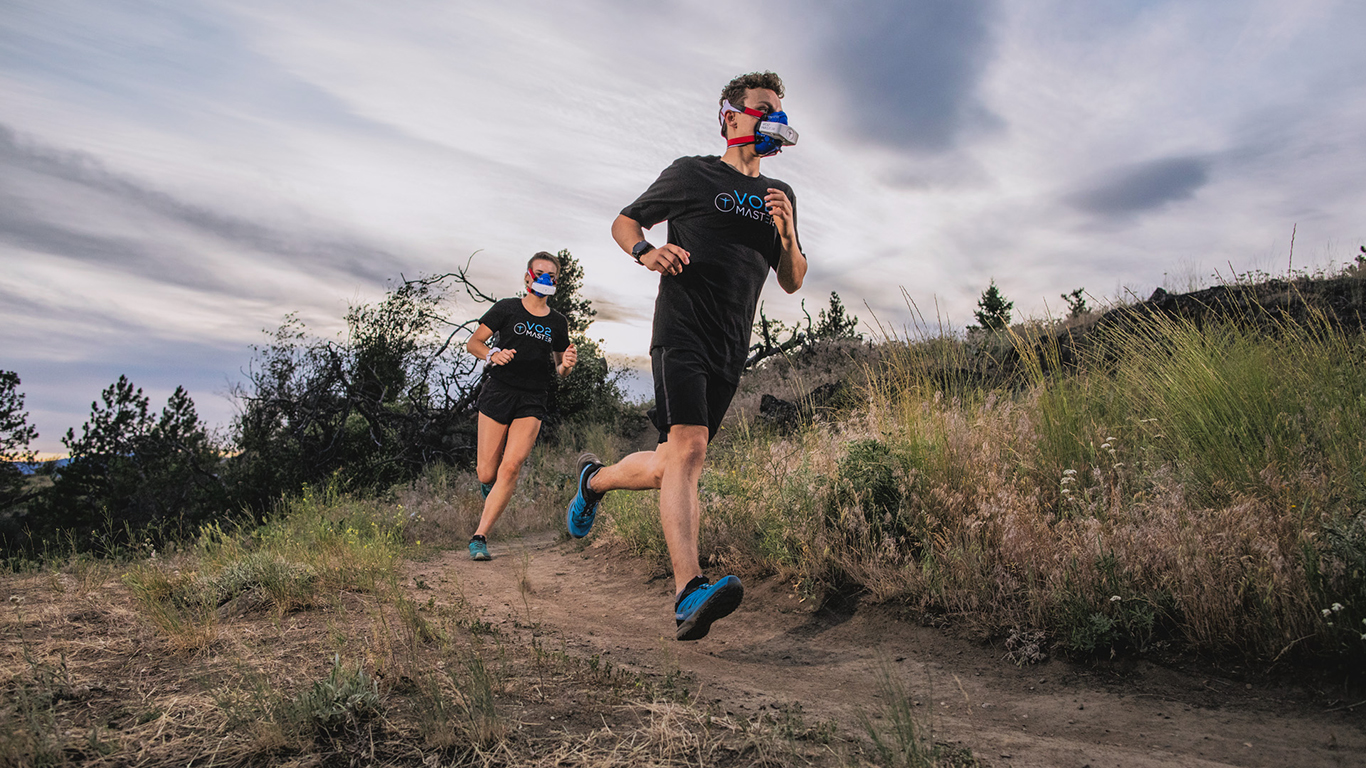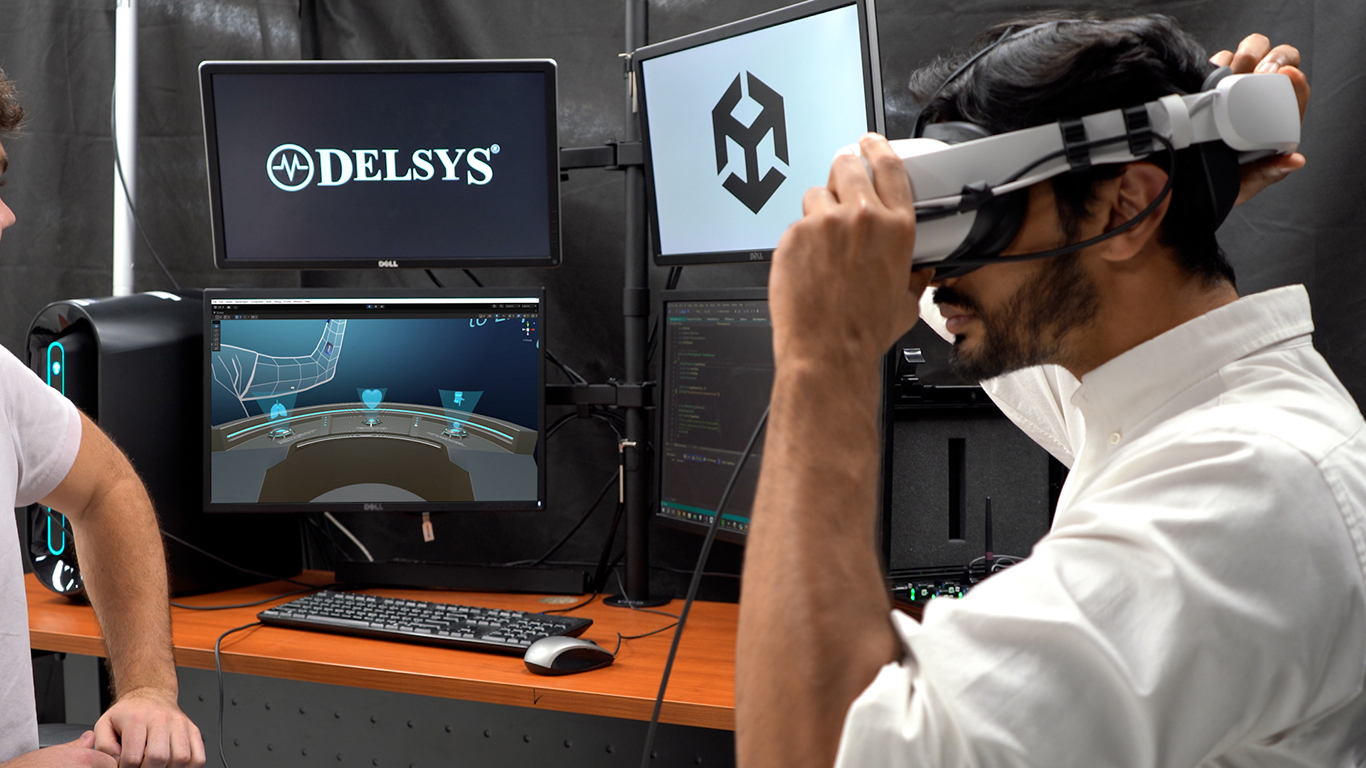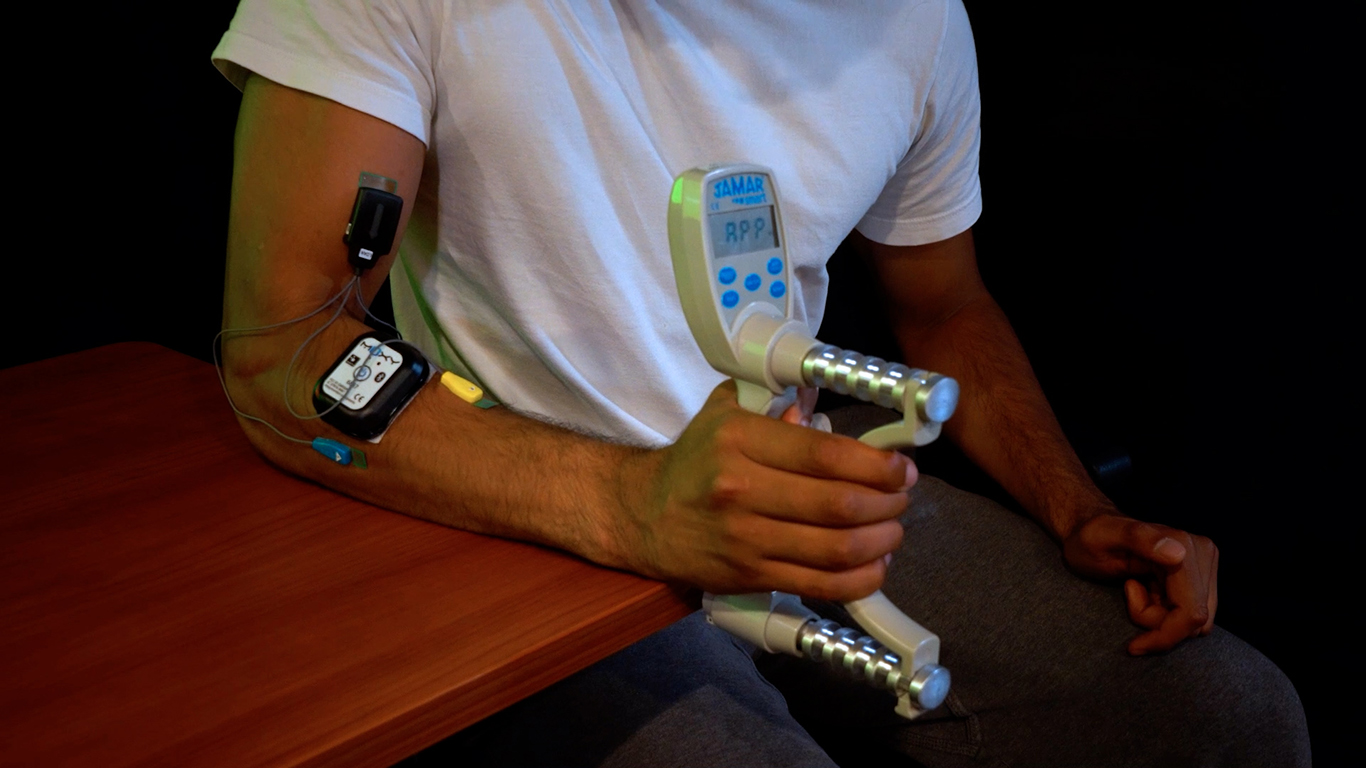Introduction
Almost 30% of all musculoskeletal injuries occur at the wrist, accounting to nearly 14 million injuries each year. The 2nd most common injury to the wrist is Carpal Tunnel Syndrome, an overuse injury that impacts 1 in 20 people around the globe.
Wrist injuries account for nearly
of ALL musculoskeletal injuries
Almost
injuries occur at the wrist each year
1 in 20
Americans are diagnosed with Carpel Tunnel Syndrome
Identifying the critical factors that cause overuse injuries like Carpal Tunnel Syndrome demands the synchronization of electromyography and handgrip force as a means of evaluating any impairment in neural signaling that affects the wrist. This integration process has been historically tedious.
Trigno Link is an intuitive integration system that solves this problem by providing a synchronous pathway for researchers to explore the relationship between electromyography and physiological data from the human body.
Below, we have outlined an experiment utilizing the Link’s integration pathway to highlight a possible mechanism of overuse injuries, in addition to a potential direction for injury prevention.
Trigno Link is an intuitive integration system that solves this problem by providing a synchronous pathway for researchers to explore the relationship between electromyography and physiological data from the human body.
Below, we have outlined an experiment utilizing the Link’s integration pathway to highlight a possible mechanism of overuse injuries, in addition to a potential direction for injury prevention.

Background
Jamar is trusted by physical therapists and certified hand therapists as a reliable and accurate tool for the evaluation of handgrip strength.
- Easy to use and provides a variety of width options to accommodate different hand sizes.
- Reports hand-grip force in pounds or kilograms and can be used to assess maximal voluntary contraction.
- Maximal handgrip strength can be a strong indicator of mortality, mobility, and bone health.
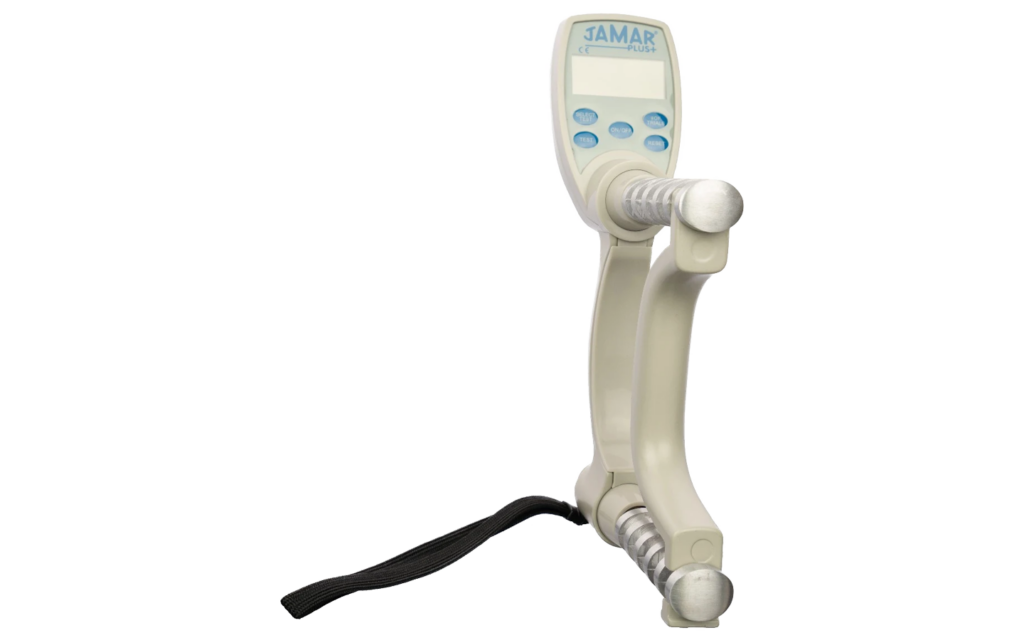

EMG is an experimental technique, typically used within human movement assessments and performance monitoring, that involves the recording and analysis of the electrical signals that emanate from the muscles during contractions and force production. By gaining insight into the status of muscular excitation, researchers, clinicians, sports practitioners, and engineers have been able to determine:
- The level of muscular effort involved –gained from assessing the overall EMG signal amplitude.
- Coordination between muscles – assessed by the activation timings of muscles.
- The effects of muscle fatigue – an exploration of the frequency component of the EMG signal.
- Neural control strategies – how the brain is adapting to training or external stimuli
With the help of Link, Trigno EMG is now the only system capable of integrating physiological and EMG data.
Benefits of integrating EMG with hand dynamometry include:
Fatigue Indication
Muscle force decreases as a product of fatigue. Alongside EMG data, this can provide a strong picture of the physiological responses to a fatiguing task.
Muscle Activation
Actual force feedback from the Jamar can be compared to electrical signals picked up by EMG sensors to allow a contrast between muscle force production and neural signaling within the body.
Assessment of Strength and Neural Health
Comparing the neural and mechanical components of force production provides researchers and clinicians with a valuable tool for rehabilitation.
Improved Training Protocols
Combining EMG with force production can help establish the mind-muscle connection, which can be improved through intentional training.
Check out a small study we conducted to demonstrate the interaction between EMG and Jamar!
Experiment Equipment
| Equipment Type | Equipment Name |
|---|---|
| Software | Trigno Discover 1.6.4 |
| EMGworks® Analysis 4.0 | |
| System | Trigno Research + Base Station |
| Hardware | Trigno Link |
| Sensor | Trigno Quattro EMG Sensor |
| Biofeedback Device | Jamar Hand Dynamometer |
| Moxy Muscle Oxygenation Sensor | |
| Polar Heart Rate Monitor |
Experiment Protocol
Our protocol was designed to monitor forearm flexor and extensor muscle activity during a sustained submaximal grasping task by using a Jamar dynamometer that presented force feedback with a slight delay to magnify cognitive load.
Here was our testing procedure.
- The participant wore a Polar Heart Rate monitor.
- One Trigno Quattro EMG sensor was placed on the skin with heads on the Flexor Carpi Radialis (FCR), Flexor Digitorum Superficialis (FDS), Extensor Carpi Radialis (ECR), and Extensor Digitorum (ED).
- One Moxy Sensor was placed on the extensor compartment muscles.
- The participant sat on a chair with their forearm resting on a table and their wrist hanging over the edge of the table. The Jamar Hand dynamometer was adjusted to fit the width of the subject’s hand.
- The participant gripped the Jamar Hand dynamometer with their dominant hand and performed a 10-second maximal contraction. The peak value was recorded as the subject’s maximal voluntary contraction (MVC).
- The participant performed a fatiguing task where they held a submaximal contraction at 50% of their MVC. The task ended when the subject could no longer maintain the 50% value.
- The participant rested for 1 hour and then repeated the above steps while wearing a wrist brace designed for people with carpal tunnel syndrome.
Acquisition and Analysis
EMG and biofeedback data were recorded using Trigno Discover 1.6.4.
Following collection, data were processed using EMGworks® Analysis to compute the change in EMG median frequency, a commonly used indicator of localized fatigue representing the accumulation of muscle metabolites that impede force development. A drop in median frequency indicates greater localized fatigue.
Results and Discussion
What are the differences in fatigability for the different forearm muscles?
Figure 1 shows the raw median frequency and force signals (left) and calculated changes in median frequency (right) for flexor (blue/orange) and extensor (grey/gold) muscles during the No Brace trial. Note that the change in median frequency shown in the extensors is much larger than the change shown in the flexors. This finding suggests that the extensors show more localized fatigue than the primary movers, the flexors. This finding may help explain why the extensors are more susceptible to overuse injuries.
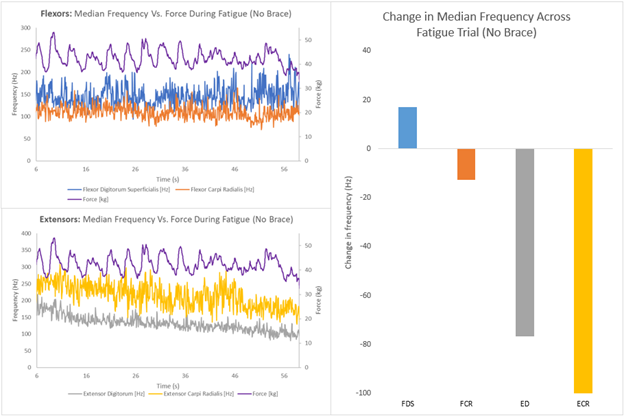
How does the brace influence fatigue in the extensor compartment muscles?
Figure 2 shows the raw median frequency and force signals (left) and calculated changes in median frequency (right) for the No Brace trial (grey/gold) and the Brace trial (blue/green). The extensor digitorum (ED) showed a 65.3Hz decrease when wearing a brace compared to a 76.6Hz decrease when not wearing a brace, and the extensor carpi radialis (ECR) showed a 61.5Hz decrease when wearing a brace compared to a 99.9Hz decrease when not wearing a brace. This indicates that wearing a brace is associated with less localized fatigue in the extensor compartment muscles.
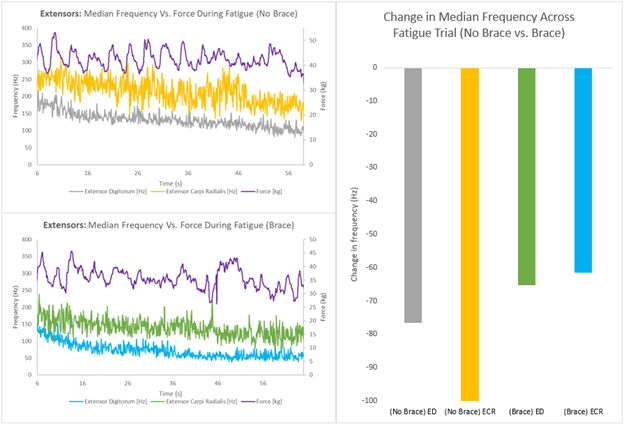
How do the other physiological variables respond?
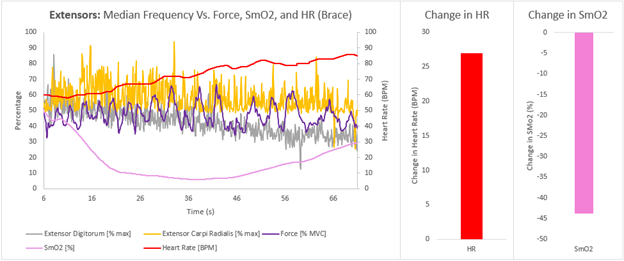
Expanding with Link
As indicated by the data above, introducing a cognitive component to a normal fatiguing task reveals that antagonistic extensor muscles fatigue more than agonistic flexor muscles. This presents a possible causal mechanism for the overuse injuries in the finger and wrist extensors. Our data show that wearing wrist brace can decrease fatigue and therefore might attenuate some risk. Researchers or clinicians interested in investigating overuse injuries like carpal tunnel syndrome should use Trigno Link to explore the effectiveness of different prevention strategies, such as bracing or taping.
Good research creates interesting questions. Even after this simple experiment, there are questions related to the factors of fatigue that present themselves. For example, why does muscle oxygenation climb after dropping off in the middle of the trial? Is this related to the steady increase in (systemic) heart rate? How does this compare to more localized (SmO2) indicators of fatigue?
These comparisons can be drawn together easily by using Trigno Link.
References
Information on the importance of hand grip strength as an indicator of health
More information on the importance of hand grip strength as a predictor of ageing
Research that supports our experimental protocol
Guide on median frequency
Carpal Tunnel Statistics
Global trends of hand and wrist trauma: a systematic analysis of fracture and digit amputation using the Global Burden of Disease 2017 Study
Carpal Tunnel Statistics
Epidemiology of hand and wrist injuries treated in a reference specialty center over a year
Carpal Tunnel Statistics
Common Hand and Wrist Injuries
Carpal Tunnel Statistics
Prevalence of Carpal Tunnel Syndrome and its associated factors among patients with musculoskeletal compliant at Dilchora Referral Hospitals in Dire Dawa administration, Eastern Ethiopia, 2022
FAQs
How exactly does the Jamar hand dynamometer output its data?
Jamar connects digitally to the Link which allows Trigno Discover to present force values in kilograms or pounds. Values are presented numerically and updated every second.
Do I need to use Trigno EMG sensors with my Trigno Link?
Yes, the Trigno Link is designed to integrate third-party biofeedback data with EMG. Therefore, the Link cannot be used without pairing a Trigno EMG sensor.
Can Trigno Link be used with other software? What about third-party software?
Currently, the Trigno Link can only be utulized within our Trigno Discover software. However, additional metrics can be brought into Trigno Discover via the use of our analog adapter or trigger module.
Trigno Link connects to both Bluetooth and ANT+ wireless devices; can it connect to both at the same time?
The Link can only connect to either Bluetooth or ANT+ at any given time. Refer to the following table for a full wireless connection compatibility guide to all our third-party devices:
| ANT+ | Bluetooth |
|---|---|
| Polar Heart Rate | Polar Heart Rate |
| Moxy NIRS Sensor | Moxy NIRS Sensor |
| Wahoo Cadence Sensor | Wahoo Cadence Sensor |
| Wahoo Bike Ergometer | VO2 Master |
| Jamar Hand Dynamometer |
Will other third-party devices be integrated with Trigno Link in the future?
Our team is constantly looking for high-quality, useful biofeedback tools that can be integrated via the Trigno Link. We are open to expanding to new devices! Do you have any products you want to see integrated with Trigno Link? Let us know!

